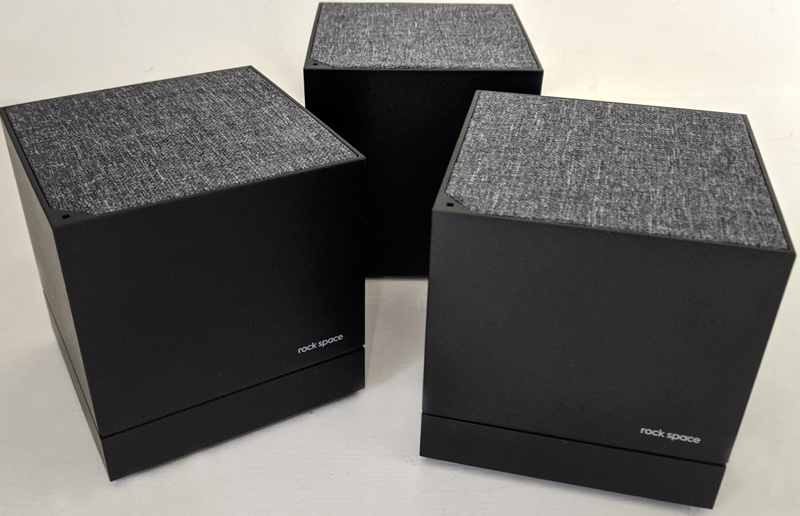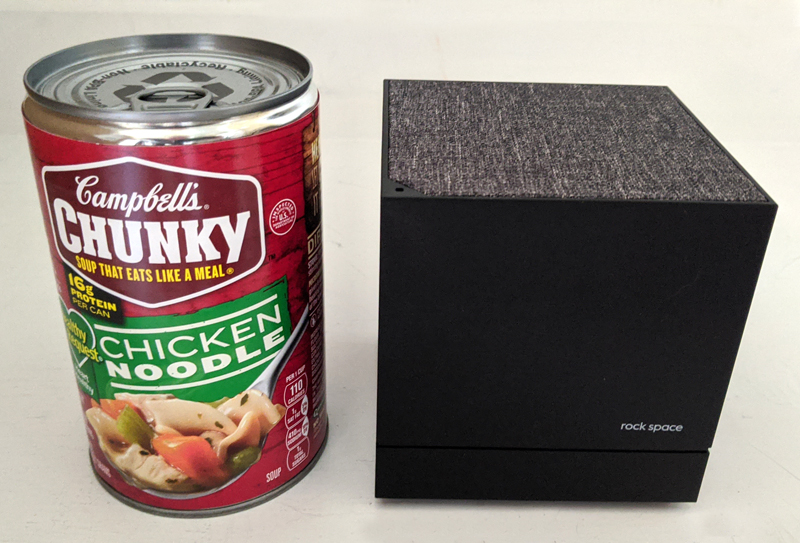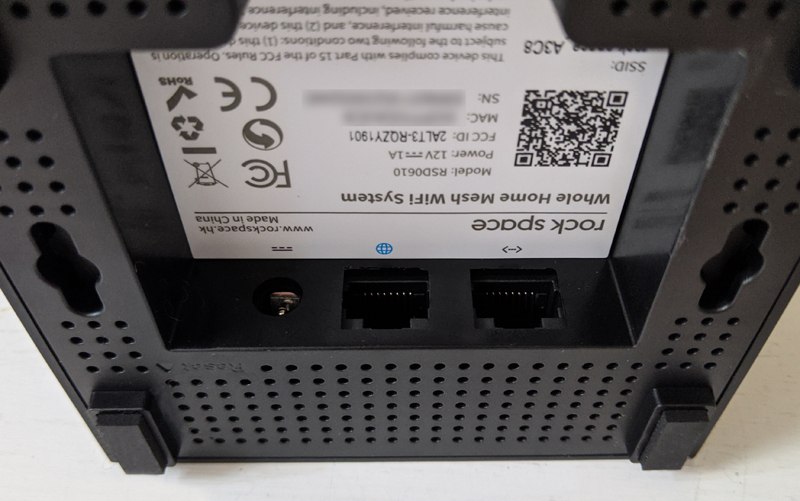REVIEW – Over the years I have tried some of those wifi repeater products to boost the wifi signal in the dead spots in our house. I was never really satisfied with the spotty results, and many of them require that you give it an SSID that is different than your main SSID. And sometimes my devices would connect to the repeater even though the wifi strength was better connecting to another repeater in the house. Anyway, I have never been really happy with those things, so I finally decided to give one of these ‘mesh wifi’ products a shot now that prices have seemingly come down as more competition is in the market. I tested the Rock Space Whole Home Mesh Wifi product to see if those pesky dead spots disappeared.
What is it?
Three small boxes that you place around your house that communicate with each other, creating a ‘mesh’ wifi network. The main box is located where your internet connection comes in the house, then it boosts the wifi signal to the other 2 boxes so that your wifi signal is stronger all over the house instead of just having 1 wifi router where the internet comes in the house. All 3 boxes also use the same SSID (name of your wireless network) and password, making it easy to simply connect to 1 wireless network.
What’s in the box?
- 3 Rock Space mesh units, with power supplies
- 1 gigabit Ethernet cable
Here are the wireless specs:
- IEEE 802.11 ac/n/a/ 5 GHz, IEEE 802.11 b/g/n 2.4 GHz
- Signal rate: 867 Mbps at 5 GHZ, 300 Mbps at 2.4 GHz
- Security: WPA/WPA2-PSK
Here are the hardware specs:
- Ports: 2 LAN/WAN gigabit Ethernet ports, DC-in 2.1mm
- Power: 12V/1A
- Size: 4 in x 4 in x 4 in
- Weight: each unit weighs 10 oz.
- Model: AC1200
Features and performance
Each mesh box is about 4 inches square, colored black, and the top has a grey fabric surface on it. On the bottom of the box are mounting holes to attach it to a wall if you wanted. On the bottom are also the connections for the power cable and 2 Ethernet ports, 1 for connecting to your existing internet connection coming into your house, or the other for connecting to the Ethernet ports you may have in the walls of your house. On top of each unit is a small LED light that gives you a status of the connection. I think it fits in with the décor in the house pretty easily and the size makes it pretty easy to place them where you need them.
Setup was pretty easy. Just follow the included instructions, which include downloading the free app. (I am on Android, and it worked great!) I plugged up the Rock Space where the internet comes into my house (in the back of the house right next to the bedroom and office). I have a 2-story shotgun-type of house that is twice as deep as it is wide. So with the internet router at the back of the house, it is almost impossible to get a good signal on the front porch, as well as on the second floor at the front of the house. So I picked the living room on the main floor at the front of the house for the second Rock Space unit (right next to our wifi-enabled Samsung TV), and the 3rd unit I placed upstairs in the bonus room at the front of the house. We have almost given up trying to get a signal in those places, so I was eager to see if the Rock Space could solve that.
Before I mention my test results, let me comment on the various features available with the Rock Space, which are many. First of all, the security features are very strong. Protecting your wireless network from hackers becomes more important every day, so having the WPA2-TSK protocol is the minimum that I would expect. In layman’s terms, what WPA2-TSK does is create a unique encrypted connection password (called a ‘key’) between the Rock Space boxes and every device on the network, and that special encrypted key is automatically, constantly changed so it is not easy to break. The technology provides a much higher level of security than just plain WPA, which hackers can break in minutes. It is true that higher levels of wireless security are rolling out, and WPA2-TSK is not impossible to break, but for now, everyone needs to be using WPA2-TSK at the very minimum.
The Rock Space also includes a firewall that provides some great features, which you set inside the app. For example, you can block specific websites you don’t want available on your network. You can create a temporary ‘guest’ wireless network and password that times out after a set amount of time. You can create groups and add devices to those groups (for example “kid’s devices”) and then add as many devices as you want to those groups. Then you can disable access to all of them with 1 click. Pretty cool. If you are going to have more than 30 devices connected at once to your network (like during a party) you can turn on ‘capacity-oriented mode’ to control the bandwidth to all the devices. The Rock Space has UPnP, which means it automatically recognizes the required ports of gaming devices, P2P devices, etc.
The Rock Space also has a feature called QoS (Quality of service), which means that you can specify what the maximum upload and download speed should be for every device on the network and no device will be able to go over those speeds. In this way, devices such as a gaming consoles or streaming movie services can’t hog the entire bandwidth. This is particularly helpful for those folks who work out of their home and don’t want the kid’s hogging the bandwidth! You cannot, however, get granular control over which devices are limited in bandwidth, which would be really nice. The limits you set apply to every device. Some other products with QoS features do provide the ability to have granular control over specific devices, but the Rock Space QoS feature is a simple version and doesn’t provide that.
The Rock Space also uses the MU-MIMO technology, which is awesome. Again, in laymen’s terms, that means that when multiple devices are using bandwidth they all share the bandwidth. Basically, that means that all devices on the network download at the same speed instead of fighting to get the same speed. It just makes things smoother and with less buffering.
Now, a word about how I tested the Rock Space
What I did first was leave my existing wireless network in place and plug the first Rock Space device into the back of my existing router using the Ethernet cable. Then I set up the other 2 Rock Space mesh devices around the house. That way, I had 2 wireless networks that I could test at the same time. So I then went around to locations in the house and tested the upload/download speeds of my existing router (I did 10 tests at each location and averaged the results). I then did the same thing with the Rock Space SSID. So I had 2 sets of results that I could use to compare the 2 different wireless networks. And yes, before you ask, when I tested the Rock Space network I disabled the SSID on the existing router so that network wouldn’t disrupt my up/down speeds!
What I discovered was that the Rock Space mesh network performed just as good as the router from my internet provider and eliminated the dead spots on the front porch and the upstairs bonus room at the front of the house because I placed the 2nd and 3rd mesh devices close to the front of the house. It was wonderful. No more dead spots! The Rock Space also has a feature called ‘fast roaming’ that will automatically switch your device to the nearest mesh device if you are moving around the house. I tested this and it worked great with my cellphone. The app even has several screens where you can see which devices are connected to each mesh device, and you can even look at how much bandwidth (up and down) that any individual device is pulling at that moment. So you can easily troubleshoot which device in your house might be hogging bandwidth at any moment. Pretty neat.
Finally, the app also lets you check for firmware updates and automatically install them on each mesh device. Nice touch.
What I like
- Great price
- Easy-to-use setup and a great smart-phone app
- Strong security
- Many firewall features
What I’d change
- Not much. I would like more granular control over individual device bandwidth usage
Final thoughts
I am now a fan of mesh networks. The convenience of having control over the network through an easy-to-use app is great, and the automatic “fast roaming” switching for my devices was seamless. Setup was easy and worked with the instructions provided. The security features provide me with some level of comfort, and the dead spots have been eliminated in my house, which is probably the best part of the whole thing. I compared the price of the Rock Space to other mesh network products and the price is very competitive. There are mesh networking devices out there that have the very latest wireless networking protocols with much higher speeds, but right now they are much more expensive, and my internet connection couldn’t take advantage of those speeds anyway. My negatives are basically none, and really the only feature I would want to see enhanced is more control over specific devices in the QoS section of the app. But at $129.99 on Amazon, I see no reason not to purchase this. If you have dead spots in your house and want more control over your network, with a strong level of security to protect yourself, the Rock Space is a great product!
Price: $149.99
Where to buy: Buy here on Amazon and Rock Space ($169.99 on their site)
Source: The sample of this product was provided by Rock Space.






Gadgeteer Comment Policy - Please read before commenting
I think you meant WPA2-PSK. Never heard of WPA2-TSK.
Ha! Tsk, tsk. You proofread the thing 4 times and still miss something. Thanks for catching that.
Would this replace my xfinity modem??
Yes, it could. Having said that, I have only tested this on my internet connection which is with AT& T. Just to do your due diligence I would make a phone call to Comcast and make sure that they will allow you to use whatever modem you want. The manufacturer says yes it will work with Comcast but I would make the phone call just to confirm.
What? These won’t replace a modem. You still need a modem, you just no longer need your ISP’s router. Did you do any research before publishing this article?
I was not clear in my answer above. What I meant to say is that you don’t have to use the wifi of the modem of your ISP… I have turned off the wifi signal on my AT&T modem and I only use the Rock Space wifi signal. You still have to have the ISP modem plugged up with the Rock Space plugged into an available ethernet port on the back of the modem. Sorry for the confusion.
Whether you can replace your ISP supplied router from a “technical” sense (not withstanding any ISP constraints) depends on what technology you’re using.
If you are using FTTP (fibre to the premise) or similar and have an NTU (Network Termination Unit) installed, then you should be able to replace the ISP router, just take the ethernet cable from the NTU and plug into the WAN port on the master node.
If you are using FTTN (fibre to the node) or FTTB (fibre to the basement) or straight old ADSL (yes, Australia still has ADSL) where there’s still some copper connection involved then you’ll need to still have an RJ12 connector from your wall plate to your ISP router. You can then take an ethernet LAN port out of the ISP router to the WAN port of the master node.
You can then turn off the WiFi on your ISP router and use the Mesh. If you’re really lucky you can actually “bridge” you’re ISP router so that you don’t have double NAT.
So the answer is, it depends 🙂
Hope this helps.